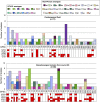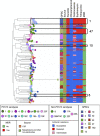Key features of pneumococcal isolates recovered in Central and Northwestern Russia in 2011-2018 determined through whole-genome sequencing
- PMID: 36112007
- PMCID: PMC9676041
- DOI: 10.1099/mgen.0.000851
Key features of pneumococcal isolates recovered in Central and Northwestern Russia in 2011-2018 determined through whole-genome sequencing
Abstract
Invasive pneumococcal disease remains one of the leading causes of morbidity and mortality worldwide. In Russia, 13- valent pneumococcal conjugate vaccine (PCV13) was introduced into the childhood immunization programme nationwide in 2014. As part of the Global Pneumococcal Sequencing Project (GPS), we used genome data to characterize 179 pneumococcal isolates collected from Russia in 2011-2018 to investigate the circulating pneumococcal strains using a standardized genomic definition of pneumococcal lineages (global pneumococcal sequence clusters, GPSCs), prevalent serotypes and antimicrobial resistance profiles.We observed high serotype and lineage diversity among the 179 isolates recovered from cerebrospinal fluid (n=77), nasopharyngeal swabs (n=99) and other non-sterile site swabs (n=3). Overall, 60 GPSCs were identified, including 48 clonal complexes (CCs) and 14 singletons, and expressed 42 serotypes (including non-typable). Among PCV13 serotypes, 19F, 6B and 23F were the top three serotypes while 11A, 15B/C and 8 were the top three among non-PCV13 serotypes in the collection. Two lineages (GPSC6 and GPSC47) expressed both PCV13 and non-PCV13 serotypes that caused invasive disease, and were penicillin- and multidrug-resistant (MDR), highlighting their potential to adapt and continue to cause infections under vaccine and antibiotic selective pressure. PCV13 serotypes comprised 92 % (11/12) of the CSF isolates from the children aged below 5 years; however, the prevalence of PCV13 serotype isolates dropped to 53 % (31/58) among the nasopharyngeal isolates. Our analysis showed that 59 % (105/179) of the isolates were predicted to be non-susceptible to at least one class of antibiotics and 26 % (46/179) were MDR. Four MDR lineages (GPSC1, GPSC6, GPSC10 and GPSC47) accounted for 65 % (30/46) of the MDR isolates and expressed PCV13 serotypes (93 %, 28/30).This study provides evidence of high genetic and serotype diversity contributed by a mix of globally spreading and regionally circulating lineages in Russia. The observations suggest that the PCV13 vaccine could be important in reducing both invasive disease and antimicrobial resistance. We also identify potential lineages (GPSC6 and GPSC47) that may evade the vaccine.
Keywords: Russia; Streptococcus pneumoniae; WGS (whole-genome sequencing); antimicrobial resistance; global pneumococcal sequence cluster (GPSC); serotypes.
Conflict of interest statement
R.A.G. reports a PhD studentship from Pfizer, outside the submitted work. S.D.B. reports personal fees from Pfizer and Merck, outside the submitted work. All other authors declare that there are no conflicts of interest.
Figures




References
-
- Ngocho JS, Magoma B, Olomi GA, Mahande MJ, Msuya SE, et al. Effectiveness of Pneumococcal conjugate vaccines against invasive pneumococcal disease among children under five years of age in Africa: A systematic review. PLoS One. 2019;14:e0212295. doi: 10.1371/journal.pone.0212295. - DOI - PMC - PubMed
-
- WHO (World Health Organization) Estimated Hib and pneumococcal deaths for children under 5 years of age [Internet]. www.who.int. 2013 [cited 2019 Jun 10] 2008. https://www.who.int/immunization/monitiring_surveillance/burden/estimate...
-
- Wahl B, O’Brien KL, Greenbaum A, Majumder A, Liu L, et al. Burden of Streptococcus pneumoniae and Haemophilus influenzae type b disease in children in the era of conjugate vaccines: global, regional, and national estimates for 2000-15. Lancet Glob Health. 2018;6:e744–e757. doi: 10.1016/S2214-109X(18)30247-X. - DOI - PMC - PubMed
-
- WHO WHO. Measuring impact of Streptococcus pneumoniae and Haemophilus influenzae type b conjugate vaccination [Internet]. 2012 [cited 2019] p. 10(7):477–477. 2012. www.who.int/vaccines-documents/
Publication types
MeSH terms
Substances
Grants and funding
LinkOut - more resources
Full Text Sources
Molecular Biology Databases
Research Materials

